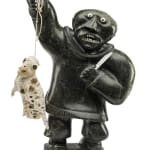-
Artworks
JUDAS ULLULAQ (1937-1999), UQSUQTUUQ (GJOA HAVEN)
Hunter with Captured Spirit, c. 1984-5stone, bone, antler, muskox horn, and waxed string, 18.25 x 12.5 x 6 in (46.4 x 31.8 x 15.2 cm)
signed, "ᐅᓗᓚ".
LOT 90
ESTIMATE: $12,000 — $18,000
PRICE REALIZED: $12,000.00Further images
Judas Ullulaq gained fame for his dynamic depictions of people (mostly hunters) whose lively faces could express a wide range of emotions and feelings: delight, fear, angst, surprise, horror, joy,...Judas Ullulaq gained fame for his dynamic depictions of people (mostly hunters) whose lively faces could express a wide range of emotions and feelings: delight, fear, angst, surprise, horror, joy, or confusion. Many of his hunters appear hapless – seemingly trapped in situations out of their control. Ullulaq the man was known for his almost boundless sense of enthusiasm and good humour; Ullulaq the artist passed those gifts along to us. So when looking at his hapless heroes, we should remember that their plights might look desperate but are not necessarily serious.
Hunter with Captured Spirit is a perfect example. Our interpretation is that the hunter has captured what he thought was a fox or similar animal, but has turned out to actually be a powerful spirit. We can only hope that the spirit is a helping spirit and not an evil one (but we must say that even if it is evil, it is awfully cute). The sculpture’s brilliance is the fact that the hunter’s expression is directed at the viewers as if to ask, “What am I supposed to do with this? What do I do now?” The spirit stares at us as well, and we can only guess at what it is thinking! We love the marvelously expressive piece of bone the artist has chosen to carve the animal spirit. We also love the careful attention to detail that Ullulaq has devoted to the sculpture as a whole, a hallmark of his work from the early 1980s.
Judas Ullulaq began making small carvings in the early 1960s, even before his move into the community of Taloyoak (Spence Bay) around 1966 or 1967. Ullulaq was among the first artists to experiment with larger-scale whale bone carving but his work, like that of so many other local talents, was overshadowed by the revolutionary art of his nephew Karoo Ashevak in the early 1970s. Ullulaq began carving more seriously in the late 1970s, and mostly in stone, but very few works of his from that decade are documented. Ullulaq’s career finally took off after 1980; he moved his family to Gjoa Haven in 1982, and was given his first solo exhibition at the Innuit Gallery in Toronto in 1983. From that time until his death in 1999 it was Ullulaq who dominated the art of the entire Kitikmeot Region.
References: For two excellent and roughly contemporaneous stone sculptures by Ullulaq see First Arts Auctions, July 2020, Lot 39; and First Arts, December 2020, Lot 23. For a discussion of Ullulaq’s life and work, and illustrations of twenty works see Darlene Coward Wight, Art & Expression of the Netsilik (Winnipeg: Winnipeg Art Gallery, 2000) pp. 152-171.Provenance
Private Collection, Toronto.
Join our mailing list
* denotes required fields
We will process the personal data you have supplied in accordance with our privacy policy (available on request). You can unsubscribe or change your preferences at any time by clicking the link in our emails.








